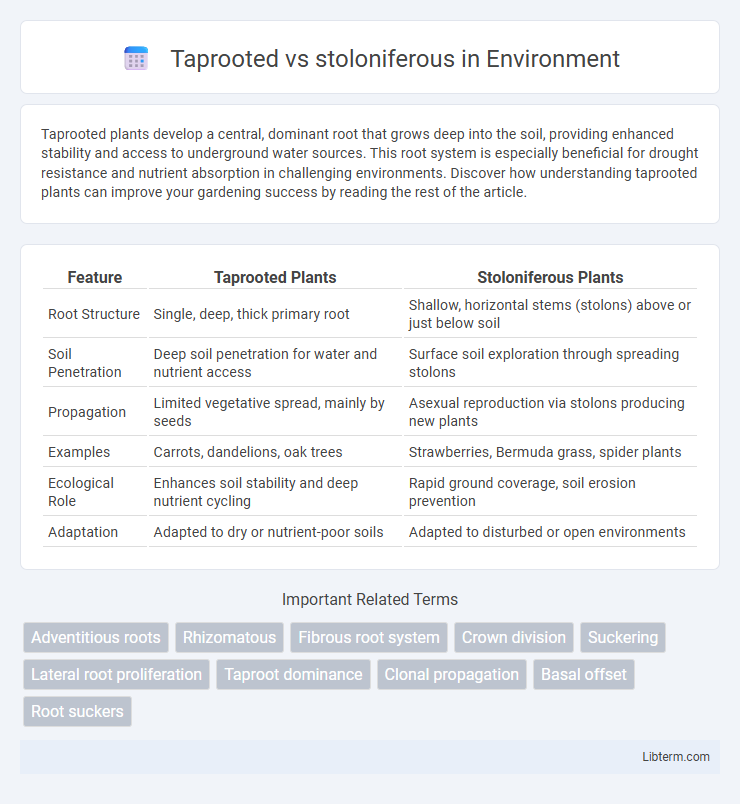Taprooted plants develop a central, dominant root that grows deep into the soil, providing enhanced stability and access to underground water sources. This root system is especially beneficial for drought resistance and nutrient absorption in challenging environments. Discover how understanding taprooted plants can improve your gardening success by reading the rest of the article.
Table of Comparison
| Feature | Taprooted Plants | Stoloniferous Plants |
|---|---|---|
| Root Structure | Single, deep, thick primary root | Shallow, horizontal stems (stolons) above or just below soil |
| Soil Penetration | Deep soil penetration for water and nutrient access | Surface soil exploration through spreading stolons |
| Propagation | Limited vegetative spread, mainly by seeds | Asexual reproduction via stolons producing new plants |
| Examples | Carrots, dandelions, oak trees | Strawberries, Bermuda grass, spider plants |
| Ecological Role | Enhances soil stability and deep nutrient cycling | Rapid ground coverage, soil erosion prevention |
| Adaptation | Adapted to dry or nutrient-poor soils | Adapted to disturbed or open environments |
Understanding Taprooted and Stoloniferous Plants
Taprooted plants develop a primary, central root that grows deep into the soil, providing strong anchor and efficient nutrient absorption from deeper layers. Stoloniferous plants propagate through horizontal stems called stolons that spread above the ground, enabling rapid colonization and vegetative reproduction. Understanding these distinct root and stem structures aids in effective cultivation, weed control, and landscape management strategies.
Key Differences Between Taproots and Stolons
Taproot systems feature a single, thick primary root that grows vertically downward, anchoring the plant and accessing deep water sources. Stolons, also known as runners, are horizontal stems that grow above ground and produce new plants at nodes, facilitating vegetative propagation. The key difference lies in taproots being primarily for nutrient and water absorption, while stolons enable asexual reproduction and colony expansion.
Structural Characteristics: Taproot vs Stolon
Taprooted plants develop a single, thick primary root that grows deep into the soil, providing strong anchorage and access to deeper water sources. Stoloniferous plants produce horizontal stems called stolons that grow along the soil surface, enabling new plantlets to form at nodes and spread rapidly. The structural distinction between a deep anchoring taproot and surface-spreading stolons reflects adaptation strategies for resource acquisition and vegetative propagation.
Examples of Taprooted Plant Species
Carrot, dandelion, and radish are prime examples of taprooted plant species, characterized by a single, thick main root that penetrates deeply into the soil to anchor the plant and absorb nutrients. These taproots store food reserves, helping the plants survive adverse conditions and regrow efficiently. Unlike stoloniferous plants like strawberries, which spread via horizontal above-ground stems, taprooted species rely on their deep, robust primary root system for stability and nutrient uptake.
Examples of Stoloniferous Plant Species
Stoloniferous plants propagate through above-ground runners called stolons, which help spread the plant horizontally, examples include strawberry (Fragaria x ananassa), spider plant (Chlorophytum comosum), and creeping Jenny (Lysimachia nummularia). These plants contrast with taprooted species, which grow deep, central roots like carrots (Daucus carota) and dandelions (Taraxacum officinale). Stoloniferous growth supports rapid colonization of new areas by producing new shoots at nodes along the stolons.
Growth Habits and Adaptations
Taprooted plants develop a central, dominant root that grows deep into the soil, providing strong anchorage and access to deep water sources, which is advantageous in drought-prone environments. Stoloniferous plants produce horizontal stems called stolons that grow along the soil surface, enabling rapid vegetative propagation and colonization of new areas, especially in nutrient-rich or disturbed habitats. These contrasting growth habits reflect adaptations to different ecological niches: taproots prioritize resource acquisition and stability, while stolons emphasize spatial expansion and resilience through cloning.
Advantages and Disadvantages of Taproots
Taproot systems offer advantages such as deep soil penetration for accessing water and nutrients unavailable to shallow roots, enhancing plant stability and drought resistance. However, taproots can limit transplant success and nutrient acquisition in shallow or compacted soils due to their single, thick main root structure. Compared to stoloniferous roots, taproots provide strong anchorage but reduce the plant's ability to spread laterally and quickly colonize new areas.
Benefits and Limitations of Stolons
Stoloniferous plants benefit from rapid vegetative propagation, allowing for efficient ground coverage and soil erosion control, but their spreading growth habit can lead to invasive tendencies and competition with neighboring plants. Stolons enable these plants to quickly colonize new areas, enhancing resilience in disturbed environments, yet they may require frequent management to prevent overcrowding and resource depletion. The ability to reproduce asexually through stolons ensures genetic uniformity but limits adaptability compared to taprooted plants that invest in deeper root systems for moisture and nutrient access.
Ecological Roles and Habitat Preferences
Taprooted plants develop a deep primary root that enhances soil stability and access to deep water reserves, making them well-adapted to arid and well-drained environments. Stoloniferous plants spread via horizontal stems or stolons, promoting rapid ground coverage and colonization in moist, disturbed, or nutrient-rich habitats. These contrasting root systems influence their ecological roles, with taprooted species often stabilizing soil and surviving drought, while stoloniferous species facilitate quick vegetative propagation and habitat recovery.
Choosing Between Taprooted and Stoloniferous Plants
Choosing between taprooted and stoloniferous plants depends on garden space and soil conditions. Taprooted plants, with their deep, central roots, are ideal for nutrient-rich, well-drained soils and provide strong anchorage, making them suitable for drought-prone areas. Stoloniferous plants spread horizontally through above-ground runners, enabling quick ground coverage and weed suppression, which benefits gardeners seeking fast soil stabilization and vegetative propagation.
Taprooted Infographic

 libterm.com
libterm.com